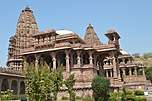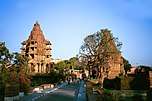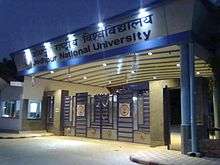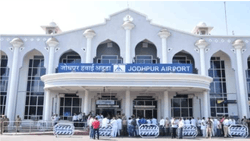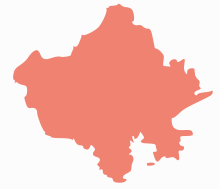Jodhpur
Jodhpur (/ˈdʒɒdpʊər/; pronounced [ˈd͡ʒoːd̪ʱpʊr] ![]()
Jodhpur | |
|---|---|
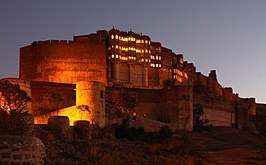 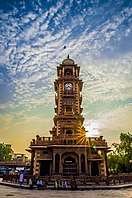 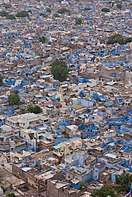 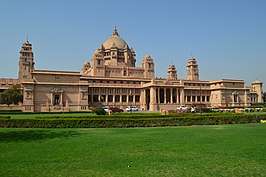 Clockwise from top left: Mehrangarh Fort, The Blue City, Umaid Bhawan Palace, Clock Tower | |
| Nickname(s): The Blue City, Sun City[1] | |
 Jodhpur  Jodhpur | |
| Coordinates: 26.28°N 73.02°E | |
| Country | |
| State | Rajasthan |
| Division | Jodhpur |
| District | Jodhpur[2] |
| Settled | 1459 |
| Founded by | Rao Jodha of Mandore |
| Named for | Rao Jodha |
| Government | |
| • Type | Mayor-council |
| • Body | Jodhpur Municipal Corporation |
| • Mayor, Municipal Corporation | Ghanshyam Ojha |
| • Collector & DM | Sh. indrajeet singh, IAS |
| • Police Commissioner of Jodhpur | Prafulla Kumar, IPS[3] |
| Area | |
| • Metropolis | 214.47 km2 (82.81 sq mi) |
| • Metro | 233.5 km2 (90.2 sq mi) |
| Elevation | 231 m (758 ft) |
| Population (2011 Census)[6] | |
| • Metropolis | 1,056,191 |
| • Rank | 44th |
| • Density | 4,900/km2 (13,000/sq mi) |
| • Metro | 1,480,000 |
| Demonym(s) | Jodhpuri, Marwari |
| Languages | |
| • Official | Hindi, English |
| • Native | Marwari, Rajasthani, Sindhi |
| Time zone | UTC+5:30 (IST) |
| PIN | 342001 |
| Telephone code | 0291 |
| ISO 3166 code | RJ-IN |
| Vehicle registration | RJ-19 |
| Website | jodhpur |
The old city circles the Mehrangarh Fort and is bounded by a wall with several gates.[8] However, the city has expanded greatly outside the wall over the past several decades. Jodhpur lies near the geographic centre of the Rajasthan state, which makes it a convenient base for travel in a region much frequented by tourists.[1]
The city is also home to several educational institutions, the most prominent being AIIMS Jodhpur, IIT Jodhpur, SNMC Jodhpur, DSRRAU Jodhpur, NLU Jodhpur, NIFT Jodhpur. Many research institutes like Indian Space Research Organisation (ISRO), Defence Research and Development Organisation (DRDO), Central Arid Zone Research Institute (CAZRI),[9] Arid Forest Research Institute (AFRI),[10] Desert Medicine Research Centre (DMRC) are also located in the city.
History
Early history
According to the Rajasthan district Gazetteer Abhiras were the inhabitants of Marwar and later on the Rajputs established their rule in Marwar. There may have been small settlements before Rathore rule.[11][12]
The Jodhpur city was founded in 1459 by Rao Jodha, a Rajput chief of the Rathore clan. Jodha succeeded in conquering the surrounding territory and thus founded a kingdom which came to be known as Marwar. As Jodha hailed from the nearby town of Mandore, that town initially served as the capital of this state; however, Jodhpur soon took over that role, even during the lifetime of Jodha. The city was located on the strategic road linking Delhi to Gujarat. This enabled it to profit from a flourishing trade in opium, copper, silk, sandalwood, dates and other tradeable goods.[13]
Early Modern period
After the death of Rao Chandrasen Rathore in 1581, the kingdom annexed by the Mughal Emperor Akbar, Marwar thus became a Mughal vassal owing fealty to them while enjoying internal autonomy. Jodhpur and its people benefited from this exposure to the wider world as new styles of art and architecture made their appearance and opportunities opened up for local tradesmen to make their mark across northern India.[13]
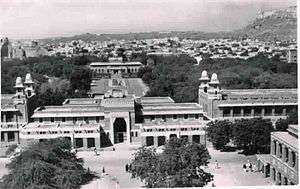
Aurangzeb briefly sequestrated the state (c. 1679) after the death of Maharaja Jaswant Singh, but the prior ruler Maharaja Ajit Singh was restored to the throne by Veer Durgadas Rathore after Aurangzeb died in 1707 and a great struggle of 30 years. The Mughal empire declined gradually after 1707, but the Jodhpur court was beset by intrigue; rather than benefiting from circumstances, Marwar descended into strife and invited the intervention of the Marathas, who soon supplanted the Mughals as overlords of the region. This did not make for stability or peace, however- 50 years of wars and treaties dissipated the wealth of the state, which sought the help of the British and entered into a subsidiary alliance with them. There was a major revolt in 1857 by some Rathore nobles of Pali led by Thakur Kushal Singh of Auwa, however, the rebels were defeated by the British army under colonel Holmes and peace was restored.[14][13]
British Colonial period
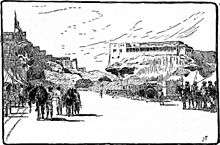
During the British Raj, the state of Jodhpur had the largest land area of any in the Rajputana. Jodhpur prospered under the peace and stability that was a hallmark of this era. The land area of the state was 93,424 km2 (36,071 sq mi) its population in 1901 was 44,73,759. It enjoyed an estimated revenue of £3,529,000. Its merchants, the Marwaris, flourished and came to occupy a position of dominance in trade across India.
Post-Independence
In 1947, when India became independent, the state merged into the union and Jodhpur became the second largest city of Rajasthan.[13][15] At the time of division, the ruler of Jodhpur, Hanwant Singh, did not want to join India, but finally, due to the effective persuasion of Sardar Vallabhbhai Patel, the Home Minister at the time, the state of Jodhpur was included in the Indian Republic. Later after the State Reorganisation Act, 1956 it was included within the state of Rajasthan.[13]
Demographics
As per provisional reports of Census India,[7] Jodhpur had a population of 1,033,918 in 2011, consisting of approximately 52.62 males and approximately 47.38 percent females. The average literacy rate is 80.56 percent, approximately 88.42 percent for males and 73.93 percent for females. Approximately 12.24 percent of the population is under six years of age. Jodhpur city is governed by a Municipal Corporation which comes under Jodhpur Urban Agglomeration. The Jodhpur Urban/Metropolitan area includes Jodhpur, Kuri Bhagtasani, Mandore Industrial Area, Nandri, Pal Village and Sangariya. Its Urban/Metropolitan population is 1,137,815 of which 599,332 are males and 538,483 are females. According to www.citypopulation.de, the population of Jodhpur city on 10/02/2020 was 1,480,000. [16]
| Population Growth of Jodhpur City | |||
|---|---|---|---|
| Census | Population | %± | |
| 1881 | 142,600 | — | |
| 1891 | 61,800 | −56.7% | |
| 1901 | 60,400 | −2.3% | |
| 1911 | 59,300 | −1.8% | |
| 1921 | 73,500 | 23.9% | |
| 1931 | 94,700 | 28.8% | |
| 1941 | 126,900 | 34.0% | |
| 1951 | 180,700 | 42.4% | |
| 1961 | 224,800 | 24.4% | |
| 1971 | 318,900 | 41.9% | |
| 1981 | 506,345 | 58.8% | |
| 1991 | 666,279 | 31.6% | |
| 2001 | 860,818 | 29.2% | |
| 2011 | 1,138,300 | 32.2% | |
| source:[17] | |||
| Year | Population |
|---|---|
| 1891 | 61,800 |
| 1901 | 60,400 |
| 1911 | 59,300 |
| 1921 | 73,500 |
| 1931 | 94,700 |
| 1941 | 126,900 |
| 1951 | 180,700 |
| 1961 | 224,800 |
| 1971 | 318,900 |
| 1981 | 506,345 |
| 1991 | 666,279 |
| 2001 | 860,818 |
| 2011 | 1,138,300 |
| 2021 | 1,521,769 |
| 2031 | 2,085,190 |
| 2041 | 2,675,986 |
| 2051 | 3,511,125 |
Climate
The climate of Jodhpur is hot and semi-arid during its nearly yearlong dry season, but contains a brief rainy season from late June to September (Köppen BSh). Although the average rainfall is around 362 millimetres (14.3 in), it fluctuates greatly. In the famine year of 1899, Jodhpur received only 24 millimetres (0.94 in), but in the flood year of 1917 it received as much as 1,178 millimetres (46.4 in).
Temperatures are extreme from March to October, except when the monsoonal rain produces thick clouds to lower it slightly. In the months of April, May and June, high temperatures routinely exceed 40 degrees Celsius. During the monsoon season, average temperatures decrease slightly. However, the city's generally low humidity rises, which adds to the perception of the heat. The highest temperature recorded in Jodhpur was on 25 May 1932 when it rose up to 48.9 degrees Celsius.[18]
| Climate data for Jodhpur (1971–2000, extremes 1968–1996) | |||||||||||||
|---|---|---|---|---|---|---|---|---|---|---|---|---|---|
| Month | Jan | Feb | Mar | Apr | May | Jun | Jul | Aug | Sep | Oct | Nov | Dec | Year |
| Record high °C (°F) | 31.2 (88.2) |
36.0 (96.8) |
41.6 (106.9) |
45.0 (113.0) |
48.9 (120.0) |
47.8 (118.0) |
42.6 (108.7) |
40.3 (104.5) |
42.5 (108.5) |
40.6 (105.1) |
37.5 (99.5) |
32.3 (90.1) |
48.9 (120.0) |
| Average high °C (°F) | 24.5 (76.1) |
27.4 (81.3) |
33.4 (92.1) |
38.4 (101.1) |
41.2 (106.2) |
40.0 (104.0) |
35.2 (95.4) |
33.5 (92.3) |
34.9 (94.8) |
35.8 (96.4) |
31.2 (88.2) |
26.9 (80.4) |
33.5 (92.3) |
| Average low °C (°F) | 9.6 (49.3) |
11.7 (53.1) |
17.3 (63.1) |
22.6 (72.7) |
26.5 (79.7) |
27.8 (82.0) |
26.4 (79.5) |
25.4 (77.7) |
23.9 (75.0) |
20.1 (68.2) |
14.7 (58.5) |
11.2 (52.2) |
19.8 (67.6) |
| Record low °C (°F) | 1.8 (35.2) |
0.7 (33.3) |
4.4 (39.9) |
15.6 (60.1) |
15.4 (59.7) |
20.0 (68.0) |
21.0 (69.8) |
21.2 (70.2) |
18.4 (65.1) |
12.5 (54.5) |
5.8 (42.4) |
1.7 (35.1) |
0.7 (33.3) |
| Average rainfall mm (inches) | 4.0 (0.16) |
4.0 (0.16) |
1.3 (0.05) |
4.8 (0.19) |
17.4 (0.69) |
40.0 (1.57) |
120.5 (4.74) |
111.8 (4.40) |
49.9 (1.96) |
6.9 (0.27) |
1.9 (0.07) |
0.5 (0.02) |
362.9 (14.29) |
| Average rainy days | 0.3 | 0.6 | 0.3 | 0.6 | 1.2 | 2.1 | 6.5 | 5.9 | 2.6 | 0.6 | 0.2 | 0.0 | 21.0 |
| Average relative humidity (%) (at 17:30 IST) | 27 | 24 | 22 | 19 | 20 | 33 | 52 | 58 | 45 | 29 | 32 | 33 | 32 |
| Mean monthly sunshine hours | 303.8 | 291.0 | 288.3 | 279.0 | 285.2 | 132.0 | 96.1 | 120.9 | 180.0 | 232.5 | 270.0 | 294.5 | 2,773.3 |
| Mean daily sunshine hours | 9.8 | 10.3 | 9.3 | 9.3 | 9.2 | 4.4 | 3.1 | 3.9 | 6.0 | 7.5 | 9.0 | 9.5 | 7.6 |
| Source: India Meteorological Department (sun 1971–2000)[19][20][18][21] | |||||||||||||
Elected representatives
The present Member of Parliament from Jodhpur is Gajendra Singh Shekhawat of the BJP.
Strategic location
Jodhpur is a significant city of western Rajasthan and lies about 250 kilometers from the border with Pakistan. This location makes it a key base for the Indian army, Indian Air Force and Border Security Force (BSF). Jodhpur's South Western Air Command is one of the Asia's largest and one of the most critical and strategically located airbases of the IAF (The Jodhpur Airport played the crucial role during the Indo-Pakistani wars of 1965 and 1971) deployed fighter jets and Advanced Light Helicopters.
Culture
Jodhpur has culturally been known by the name of jodhana by the locals.[22] The city is famous for its food and its popularity can be judged by the fact that one can find sweet shops named "Jodhpur Sweets" in many cities throughout India. Being at the onshore of Thar desert, life has been influenced by ways of select nomadic tribes (So-called "Gypsy" groups - Banjare in Hindi - have settled in some parts of the city).[23] Jodhpur has distinct cultural identity through its food and is famous for its Mirchi Bada and Mawa Kachori.[24]
Tourism
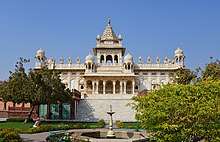
Jodhpur's most notable attractions are Mehrangarh Fort which overlooks upon the city, the blue bylanes of the old city are also an attraction, Umaid Bhawan Palace, Jaswant Thada, and the Ghanta Ghar, or Clock Tower. Tourists are also within proximity to Mandore Garden, Kaylana Lake and Garden, Balsamand Lake, Rao Jodha Desert Rock Park, Ratanada Ganesh Temple, Toorji Ka Jhalra, Sardar Samand Lake and Palace, Masooria Hills, Veer Durgadas Smarak (monument, park, and museum) and Bhim Bhadak Cave. Other attractions of people are at markets of food, antique items, traditional clothes and traditional shoes (also called Jodhpuri Mojari) held in Jodhpur.[25]
Motion picture industry
The city is famous for its charming locations and is often featured in various films, advertisements, music videos and soaps. The historic buildings and landscapes of the city were featured in a number of movies, including The Dark Knight Rises directed by Christopher Nolan,[26] Baadshaho starring Ajay Devgn and Emraan Hashmi,[27] The Darjeeling Limited starring Owen Wilson, Adrien Brody, and Jason Schwartzman, The Fall directed by Tarsem Singh, "Hum Saath-Saath Hain" directed by Sooraj Barjatya, "Veer" directed by Anil Sharma, "Shuddh Desi Romance" directed by Maneesh Sharma[28] and "I" directed by S. Shankar, "Kung Fu Yoga" starring Jackie Chan, Sonu Sood, Disha Patani, "Loafer" starring Varun Tej and Disha Patani; Supreme (film) starring Sai Dharam Tej and Rashi Khanna; Airlift feat.in Akshay Kumar and Nimrat Kaur.[29]
Cuisine
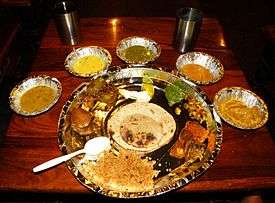
A number of dishes from Indian cuisine originated in Jodhpur, such as Makhaniya Lassi,[30] Mawa Ki Kachori, Pyaaj Ki Kachori (kachori of onion), Hot & Spicy Mirchi Bada, Dal Bati Churma, Lasan Ki Chutney (special gravy of garlic), Mirchi Ka Kutii, Gatte Ki Sabzi, Ker Sangri Sabzi, Raab, Lapsi, Aate Ka Halwa, Kachara Mircha Sabzi and Kadhi Pakoda with Baajre Ka Sogra.
Sports
Jodhpur has two outdoor stadiums and one indoor stadium complex. Barkatullah Khan Stadium has hosted two cricket ODIs. Umaid stadium football stadium and Gaushala maidan sports stadium.
| S No | Team (A) | Team (B) | Winner | Margin | Year |
|---|---|---|---|---|---|
| 1 | By 1 wicket | 2000 | |||
| 2 | By 3 wickets | 2002 | |||
Education and research
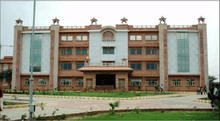

Educational facilities include:
- Indian Institute of Technology Jodhpur (IITJ) is a technical education institute in India, one of the new IITs.
- All India Institute of Medical Sciences Jodhpur (AIIMS Jodhpur).
- National Law University Jodhpur (NLU Jodhpur) is one of the 17 universities imparting law education (established in 1999).
- National Institute of Fashion Technology Jodhpur (NIFT Jodhpur): a fashion design institute (started in 2010).
- Dr. Sarvepalli Radhakrishnan Rajasthan Ayurved University (DSRRAU Jodhpur) is a university in the field of Ayurveda. The second university of its kind in India was started in 2003.
- Jai Narain Vyas University (JNVU, Jodhpur), formerly known as University of Jodhpur, is run by the State Government of Rajasthan (established in 1962).
- Dr. S.N. Medical College, Jodhpur (established in 1965).
- MBM Engineering College: the oldest engineering institution in Rajasthan, now a faculty of Engineering and Architecture, under JNVU (established in 1951).
- Footwear Design and Development Institute Jodhpur (FDDI Jodhpur) is an institute established by the Government of India, Ministry of Commerce & Industry for the design and development of footwear, fashion and leather (started in 2012).
- Indian Institute of Handloom Technology (IIHT Jodhpur) is one of the five institutes nationwide to provide research, development and technical education to the handloom industry.
- Sardar Patel University of Police, Security and Criminal Justice, started in 2013, is a university for research and education in the field of security, policing and criminal justice.
Research
Major research institutes and organizations have been established in the city for promoting research:
- Arid Forest Research Institute is one of the institutes of the Indian Council of Forestry Research and Education (ICFRE) working under the Ministry of Environment & Forests, Govt. of India for carrying out scientific research in forestry to provide technologies to increase the vegetative cover and to conserve the biodiversity in the hot arid and semi-arid region of Rajasthan, Gujarat and Dadara union, and Nagar Haveli union territory. The campus covers 66 hectares on the New Pali Road.
- Central Arid Zone Research Institute (CAZRI) is a premier Organisation of the Indian Council of Agricultural Research (ICAR), an autonomous organization under the Department of Agricultural Research and Education, Ministry of Agriculture, Government of India.
- Desert Medicine Research Centre (DMRC) is one of the 33 permanent institutes of Indian Council of Medical Research which is an autonomous body for the formulation, coordination and promotion of biomedical research in the country.
- Desert Regional Centre, Zoological Survey of India (DRC-ZSI) is the regional arm of the only taxonomic organization in the country involved in the study of all kinds of animals to promote survey, exploration, and research leading to the advancement of zoological study.
- Botanical Survey of India (BSI) is the nodal research organization under Ministry of Environment and Forests for research, exploration, and survey of the flora of India.
- Defence Research and Development Organisation (DRDO) is an organization working under the Department of Defence Research and Development of Ministry of Defence for design and development leading to the production of world-class weapon systems and equipment.
- Regional Remote Sensing Centre (RRSC, ISRO) is one of the five centre established under National Natural Resources Management System (NNRMS) by Department of Space for remote sensing tasks at regional and national levels.
- MBM Engineering College: Research in Master and Ph.D. programs in branches of engineering is done by highly experienced faculty. In civil and chemical engineering, national and state projects are performed by this college.
Judiciary
Rajasthan High Court is the High Court of the state of Rajasthan. It was established on 21 June 1949 under the Rajasthan High Court Ordinance, 1949.
The High Court of Rajasthan was founded in 1949 in Jodhpur and was inaugurated by the Rajpramukh, Maharaja Sawai Man Singh on August 29, 1949. The first Chief Justice was Kamala Kant Verma and the current Chief Justice of the Rajasthan High Court is the Honorable Justice Indrajit mohanty. A bench was formed at Jaipur which was dissolved in 1958 and was again formed on January 31, 1977. Currently, there are forty sanctioned judges.
Civic administration
| Jodhpur City officials | |
|---|---|
| Mayor | Mr. Ghanshyam Ojha |
| Collector | Shri Prakash Rajpurohit IAS,[31] IAS |
| Police Commissioner | Mr. Prafull KumarIPS |
| Chief Justice of the Rajasthan High Court | Hon'ble Mr. Justice Pradeep Nandrajog |
| Chairman, Jodhpur Development Authority | Mr. Babulal Kothari |
The city is administered by the Jodhpur Nagar Nigam headed by a mayor. For administrative purposes, the city is divided into 65 wards, from which the members of the corporation council are elected for five years. The municipal corporation has 65 elected members known as councilors, or parshad in Hindi, representing their respective wards (65 geographical units of the city). The ward members are elected by direct voting by electorate for a period of 5 years. In addition to these 65 directly elected members, the corporation has 4 Ex-officio members (1 member of parliament, 3 members of legislative assembly, namely Sardarpura, Soorsagar, City) and 3 Nominated Members.
Transportation
The city has well-established rail, road and air networks connecting it to other major cities of the country.
Railways
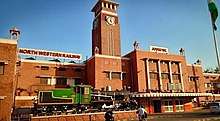
Jodhpur railway station is the divisional headquarters of the North Western Railways (NWR). It is well connected with railways to major Indian cities like Alwar, Delhi, Mumbai, Kolkata, Chennai, Bangalore, Thiruvanathapuram, Kochi, Pune, Kota, Kanpur, Bareilly, Hyderabad, Ahmedabad, Indore, Bhopal, Dhanbad, Patna, Guwahati, Nagpur, Lucknow, Gwalior, Jaipur etc. To decongest the main Jodhpur station (JU), the suburban station Bhagat ki Kothi (BGKT) is being developed as the second main station for passenger trains. At present 106 trains serves to both the stations. Some of the important trains originating from Jodhpur railway station are- Ranthambore Express (Jodhpur to Indore), Mandore Express (Jodhpur to Delhi), Suryanagri Express (Jodhpur to Mumbai), Marudhar Express (Jodhpur to Varanasi), Howrah Superfast (from Jodhpur to Howrah) etc.
Luxury train service: For experiencing the true magnificence and royal opulence of Rajasthan, luxury trains Palace on Wheels and Royal Rajasthan on Wheels and Maharaja Express are run jointly by RTDC and Indian railways.[32] Jodhpur is one of the destinations of both of the trains. Recently a plan to start metro train service in Jodhpur was proposed to decongest the city traffic. However, this proposal is still pending with the state government for its approval.[33]
Suburban stations around Jodhpur:
| No. | Suburban Station Name[34] | Distance (in km) |
|---|---|---|
| 1 | Raikabagh Palace Junction | 02 |
| 2 | Bhagat Ki Kothi railway station | 03 |
| 3 | Mahamandir Railway Station | 05 |
| 4 | Basni Railway Station | 06 |
| 5 | Jodhpur Cantt Railway Station | 08 |
| 6 | Mandor Railway Station | 10 |
| 7 | Banar Railway Station | 14 |
| 8 | Salawas Railway Station | 16 |
Air
Jodhpur Airport is one of the prominent airports of Rajasthan. It is primarily a military airbase with a civil enclosure to allow for civilian air traffic. Due to Jodhpur's strategic location, this airport is regarded as one of the most important ones for the Indian Air Force.[35]
At present, there are daily flights from Delhi and Mumbai to the city operated Air India Indigo, Spicejet and Vistara. There are also daily flight to Ahmedabad operated by Indigo and Spicejet as well as to Bengaluru by Indigo. The bill and basic formalities for the long-awaited expansion of the airport were cleared by all the concerned authorities in June 2016, clearing the way for the expansion of the airport in two phases beginning February 2016. Post the expansion, it is expected that there will be morning and evening flights from the city to more cities than presently available in addition to more airlines coming to and fro the city.[35]
Road
Jodhpur is connected by road to all major cities in Rajasthan and neighboring states like Delhi, Ahmedabad, Surat, Ujjain, and Agra. Apart from deluxe and express bus services to cities within the state, Rajasthan Roadways provides Volvo and Mercedes Benz bus service to Delhi, Ahmedabad, Jaipur, Udaipur, and Jaisalmer. Recently, Bus Rapid Transit System (BRTS) is launched in the city with low floor and semi-low floor buses plying on major routes. Jodhpur is connected to the National Highway network with three National Highways and to the Rajasthan State Highway network with ten state highways. National Highways passing through Jodhpur:
- NH-62, Ambala-Kaithal-Hissar-Fatehpur-Jodhpur-Pali; total length = 690 km
- NH-112, Junction with NH-14 near Bar connecting Jaitaran-Bilara-Kaparda-Jodhpur-Kalyanpur-Pachpadra-Baloootra-Tilwara-Kher-Bagundi-Dhudhwa-Madhasar-Kawas and terminating at its junction with NH 15 near Barmer; total length= 343 km
- NH-114, Junction with NH-65 near Jodhpur connecting Balesar - Dechhu and terminating at its junction with NH-15 near Pokaran; total length= 180 km
State Highways passing through Jodhpur:
- SH-19, Phalodi (NH 15) to Needar via Ahu, Chadi, Pachudi, Nagaur, Tarneu, Khatu Kalan, Khatu khurd, Toshina, Kuchaman City, Bhuni, Maroth, Deoli Minda, Renwal Crossing, Kaladera; total length = 368 km
- SH-21, Dantiweara to Merta City via Pipar City, Borunda; total length = 97 km
- SH-28, Phalodi (NH 15) to Ramji ki Gol via Deeechu, Shergarh, Pachpadra, Balotra, Sindri, Guda Malani; total length = 259 km
- SH-58, Jodhpur to Bheem up to NH 8 via Vinakiya, Rajola Sojat, Rendiri, Bhaisana, Sojat Road, Kantalia, Baban; total length = 142 km
- SH-61, Phalodi (NH 15) to Mandal via Osian, Mathania, Jodhpur, Khejrali, Bhatenda, Saradasamand, Jadan, Marwar Junction, Auwa, Jojawar, Kamalighat, Devgarh, Rajaji ka kareda; total length = 349 km
- SH-62, Bilara to Pindwara via Sojat, Sireeyari, Jojawar, Bagol, Desuri, Sadri, Sewari; total length = 187 km
- SH-63, Banar to Kuchera via Bhopalgarh Asop; total length = 129 km
- SH-65, Sheo (NH 15) to Shergarh via Bhiyad, Barnawa Jagger, Patodi, Phalsoond; total length = 155 km
- SH-66, Siwana to Dhandhaniya (NH 114) via Samdari, Kalyanpur, Mandli Rodhawa Kalan; total length = 90 km
- SH-68, Dangiyawas (NH 112) to Balotra via Kakelao, Khejarli, Guda Kakani, Luni, Dhundhara, Rampura, Samdari; total length = 131 km
Media
Newspapers
- Rajasthan Patrika
- Dainik Bhaskar[36]
- Dainik Navjyoti
Radio
Jodhpur has total of five FM stations:
- Big FM
- Red FM
- My FM
- Vividh Bharti
- Radio Mirchi
- All India Radio
Notable people
- Maharaja Gaj Singh
- Ashok Gehlot
- Justice Dalveer Bhandari
- Chitrangada Singh
- Ravi Bishnoi (U-19 Indian Player)
- Gajendra Singh Shekhawat
- Major Shaitan Singh Bhati
See also
References
- "These Spectacular Shots Of India's 'Blue City' Will Ignite Your Wanderlust". HuffPost. 27 April 2016.
- "Jodhpur.nic.in". Archived from the original on 19 February 2012. Retrieved 25 January 2012.
- बीजू जॉर्ज जोसेफ जोधपुर के नए पुलिस कमिश्नर, राघवेंद्र सुहासा जोधपुर रेंज के नए डीआईजी होंगे, मानाराम पटेल अतिरिक्त संभागीय आयुक्त. Dainik Bhaskar. 2018.
- "Jodhpur District Census 2011 Handbook: VILLAGE AND TOWN WISE PRIMARY CENSUS ABSTRACT (PCA)" (PDF). Censusofindia.gov.in. p. 33. Retrieved 19 April 2016.
- "Statical Information". Jodhpur Municipal Corporation. Retrieved 11 October 2019.
- ORGI. "Census of India : Provisional Population Totals Paper 1 of 2011 : Rajasthan".
- "Jodhpur City Population Census 2011 - Rajasthan".
- Gopal, Madan (1990). K.S. Gautam (ed.). India through the ages. Publication Division, Ministry of Information and Broadcasting, Government of India. p. 178.
- "Central Arid Zone Research Institute". 12 April 2019 – via Wikipedia.
- "Arid Forest Research Institute". 1 May 2019 – via Wikipedia.
- Rajasthan [district Gazetteers].: Jodhpur-page-18
- Rajasthan [district Gazetteers].: Jodhpur – Rajasthan (India). Government Central Press. 1979.
- Dhananajaya Singh (1994). The House of Marwar: The Story of Jodhpur. Lotus Collection. ASIN B003FD2ISQ.
- Political Awakening and Indian Freedom Movement with Special Reference to Rajasthan pg 28-35
- Dr. M.S. Navarane (1999). The Rajputs of Rajputana: A Glimpse of Medieval Rajasthan. APH Publishing. ISBN 81-7648-118-1.
- "Major Agglomerations of the World - Population Statistics and Maps". citypopulation.de.
- "INDIA : urban population". www.populstat.info.
- "Highest Maximum Temperature (°C) Ever Recorded" (PDF). India Meteorological Department. Retrieved 6 April 2020.
- "Station: Jodhpur RS/RW Climatological Table 1971–2000" (PDF). Climatological Normals 1971–2000. India Meteorological Department. October 2011. pp. 365–366. Archived from the original (PDF) on 15 February 2020. Retrieved 6 April 2020.
- "Extremes of Temperature & Rainfall for Indian Stations (Up to 2012)" (PDF). India Meteorological Department. December 2016. p. M183. Archived from the original (PDF) on 5 February 2020. Retrieved 6 April 2020.
- "Table 3 Monthly mean duration of Sun Shine (hours) at different locations in India" (PDF). Daily Normals of Global & Diffuse Radiation (1971–2000). India Meteorological Department. December 2016. p. M-3. Archived from the original (PDF) on 5 February 2020. Retrieved 6 April 2020.
- "४५८ साल में जोधाणा से ऐसे जोधपुर बन गया यह शहर". Dainik Bhaskar (in Hindi).
- "Feeling blue in Jodhpur". outlookindia.com.
- "5 Best Rajasthani recipes". NDTV.
- Staff, Travel (25 April 2018). "Jodhpur Tourism: 5 Reasons to Visit India's Blue City This Winter". India.com.
- "Why Jodhpur locals thought the Dark Knight cast was nuts". Firstpost. 10 July 2012.
- "Why the 'Baadshaho' team travelled 5000 kilometers…". The Times of India. 5 August 2017.
- "ये है राजस्थान की Blue City, बॉलीवुड से हॉलीवुड तक की पहली पसंद" (in Hindi). Dainik Bhaskar. 13 January 2016.
- "Twinkle Khanna, kids Nitara-Aarav in Jodhpur for dad Akshay Kumar's shoot". The Indian Express. 12 November 2015.
- Kalyani Prasher (27 May 2016). "Stirring things up in Jodhpur". Business Line. Retrieved 13 March 2019.
- "Archived copy". Archived from the original on 10 April 2014. Retrieved 29 March 2014.CS1 maint: archived copy as title (link)
- "New-look Palace on Wheels set to chug off on Aug 5". Times of India. 2 August 2009.
- "जयपुर के बाद अब जोधपुर में भी मेट्रो". Amar Ujala.
- Gupta, Divyanshu. "Jodhpur Railway Station Map/Atlas NWR/North Western Zone - Railway Enquiry". indiarailinfo.com.
- "MoU inked to expand Jodhpur airport". The Times of India. 27 March 2017. Retrieved 9 March 2018.
- "Dainik Bhaskar Jodhpur". Dainik Bhaskar. Retrieved 23 February 2020.
Further reading
- Jodhpur, Published by [s.l.], 1933.
- Maharaja of Marwar 1973.
- Marwar under Jaswant Singh, (1658–1678): Jodhpur hukumat ri bahi, by Satish Chandra, Raghubir Sinh, Ghanshyam Dattan Singh of Jodhpur and His Times (1803–1843 A.D.), by padmaja Sharma. Published by Shiva Lal Agarwala, 1972.
- The Administration of Jodhpur State, 1800–1947 A.D., by Nirmala M. Upadhyaya. International Publishers, Sharma. Published by Meenakshi Prakashan, 1976.
- The History of Rajputana-Vol.IV, PartII. The History of the Jodhpur State, Part II, Veer Durgadas. 1941, Dr. Gaurishankar Hirachand Ojha.
- Jodhpur, Bikaner, Jaisalmer: Desert Kingdoms, by Kishore Singh, Karoki Lewis. Lustre Press Ltd. 1992.
- The House of Marwar: The Story of Jodhpur, by Dhananajaya Singh. Lotus Collection, Roli Books, 1994. ISBN 81-7436-002-6.
- Modern Indian Kingship: Tradition, Legitimacy & Power in Jodhpur, by Marzia Balzani. Published by James Currey Limited, 2003. ISBN 0-85255-931-3.
- Rathod Durgadas by Pt. Bishweshharnath Reu, 1948, Archaeological Department, Jodhpur.
- Veer Durgadas Rathor by Dr. L. S. Rathore, Thar Bliss Publisher, Jodhpur, 1987.
- Jodhpur and the Later Mughals, AD 1707–1752, by R. S. Sangwan. Published by Pragati Publications, 2006.
- Jaysom Uppadhyay (1650/1980), Mantri Karam Chand Vanshavali Prabandh (Hindi), Bhartiya Vidhya Bhawan (under Singhi Jain Granthmala series), Mumbai.
- Pandit Gaurishankar Hirachand Ojha (1999–2006). Udaipur Rajya ka Itihasa (History: Kingdom of Udaipur). Publisher: Rajasthani Granthaghar, Jodhpur.
- Pratap Singh Mehta (2016). Rajputana Chronicles: Guns and Glories – The thousand-year story of the Bachhawat clan, Notion Press Media, Chennai. ISBN 978-93-5206-600-1
External links
| Wikimedia Commons has media related to Jodhpur. |
| Wikiquote has quotations related to: Jodhpur |
| Wikivoyage has a travel guide for Jodhpur. |
- Official website
- Jodhpur at Rajasthan Tourism Website

